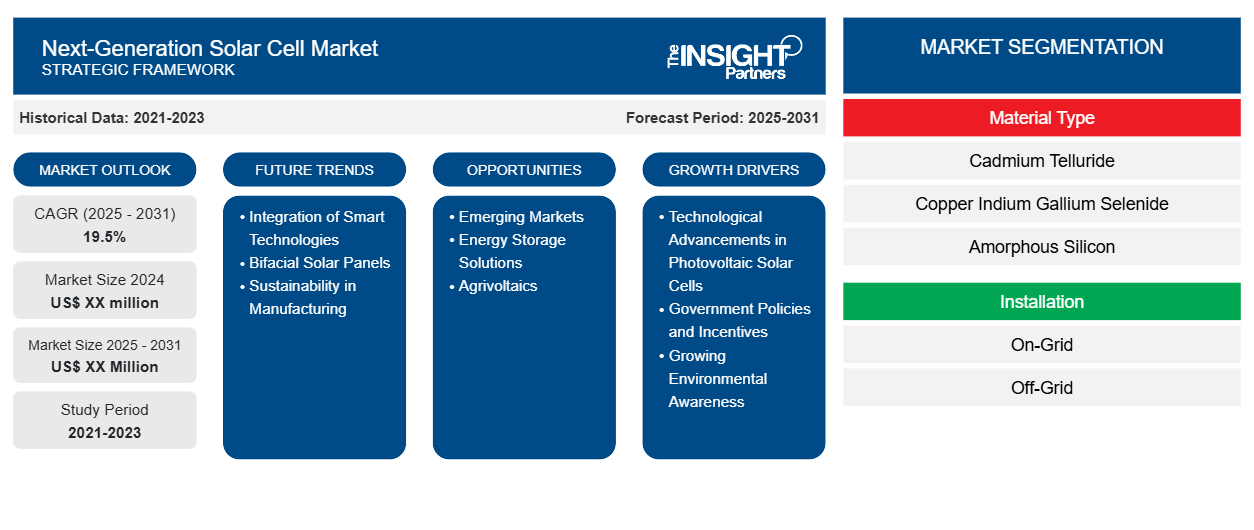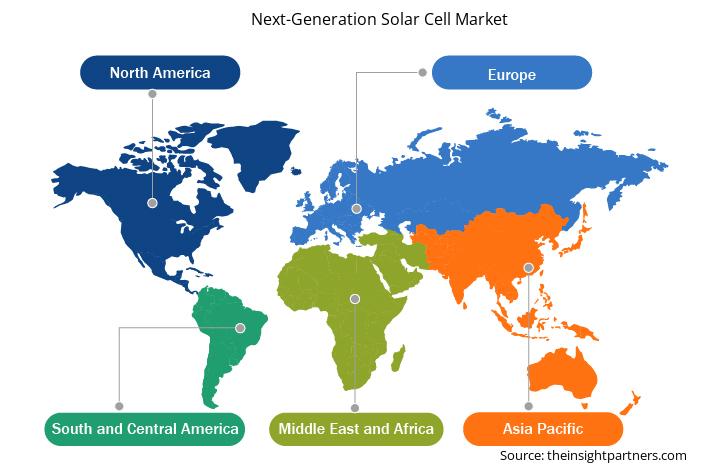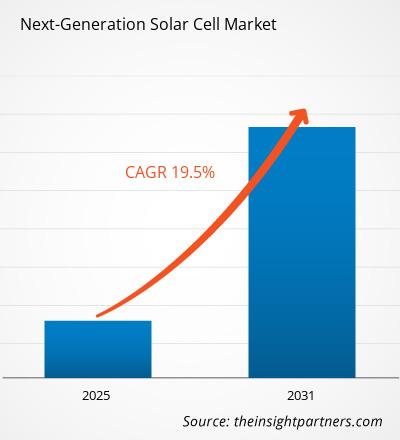世界の次世代太陽電池市場規模は、2024年に41億3,000万米ドルと評価され、2031年までに129億5,000万米ドルに達すると予想されています。次世代太陽電池市場は、2025年から2031年にかけて15.73%のCAGRを記録すると予測されています。持続可能性とグリーン製造は、引き続き市場の重要なトレンドとなる可能性があります。
次世代太陽電池市場分析
次世代太陽電池市場は、クリーンエネルギーへの世界的な推進、太陽光発電技術の革新、そしてエネルギー消費パターンの変化を背景に、急速に成長を遂げています。市場を牽引する主要な要因の一つは、高効率で低コストの太陽光発電ソリューションに対する需要の高まりです。ペロブスカイト太陽電池、有機太陽電池(OPV)、タンデム太陽電池といった次世代技術は、エネルギー変換率の向上、柔軟性、軽量設計を特徴としており、建物一体型太陽光発電からポータブル電子機器まで、幅広い用途で魅力的な選択肢となっています。環境への懸念の高まりとネットゼロへのコミットメントは、政府や企業による先進的な再生可能エネルギー技術への投資を促しています。欧州、北米、アジア太平洋地域など、地域をまたぐ様々なインセンティブ、補助金、そして研究開発資金の提供は、新興太陽光発電技術の商業化を加速させています。
次世代太陽電池市場の概要
次世代太陽電池は、太陽光発電技術の進化を象徴するものであり、従来のシリコンベースの太陽電池パネルと比較して、より高い効率、より低い製造コスト、そしてより優れた汎用性を提供します。これらの先進的な太陽電池には、ペロブスカイト、有機薄膜太陽電池(OPV)、量子ドット、多接合、薄膜セルなどの技術が含まれます。これらの技術は、様々な照明条件下で優れた性能を発揮し、軽量で柔軟なフォームファクターを備え、幅広い表面や製品への統合が可能であるため、従来システムの限界を克服するように設計されています。さらに、製造コストの低減と容易な拡張性も期待できるため、これらの技術は大規模導入にも魅力的です。企業は、政府の支援政策や持続可能性に関する規制に支えられ、次世代太陽光発電ソリューションの商業化に向けて、研究開発への投資や戦略的パートナーシップの構築をますます進めています。世界経済がよりクリーンなエネルギーとカーボンニュートラルの目標へと移行する中で、次世代太陽電池は戦略的資産として位置付けられ、企業のイノベーション、エネルギーコストの削減、そして長期的な環境への取り組みへの適合を可能にします。
このレポートの一部、国レベルの分析、Excelデータパックなど、あらゆるレポートを無料でカスタマイズできます。また、スタートアップや大学向けのお得なオファーや割引もご利用いただけます。
次世代太陽電池市場:戦略的洞察

- このレポートの主要な市場動向を入手してください。この無料サンプルには、市場動向から見積もりや予測に至るまでのデータ分析が含まれます。
次世代太陽電池市場の推進要因と機会
軽量で柔軟なソリューションに対する需要の高まりが市場を有利に導く
産業界が再生可能エネルギーを非伝統的、モバイル、かつスペースに制約のある用途に統合しようと模索する中、軽量でフレキシブルな太陽光発電技術の需要が急速に高まっています。従来のシリコンベースの太陽電池パネルは硬く、重く、フォームファクターが限られているため、航空宇宙、自動車、家電、建設などの分野での活用が制限されています。次世代太陽電池、特に薄膜、有機薄膜(OPV)、ペロブスカイトベースのセルは、大きな利点を提供します。これらの技術は、プラスチック、ガラス、金属箔などの軽量でフレキシブルな基板上に製造できるため、曲面や移動面への設置に最適です。例えば、航空宇宙技術やドローン技術では、重量が重要な要素となります。超軽量のソーラーフィルムは、飛行時間を延長し、質量を大きく増やすことなく車載システムに電力を供給します。自動車分野では、フレキシブルな太陽電池パネルが車両のルーフや窓に取り付けられ、バッテリーの充電や車載システムへの電力供給に利用されており、エネルギー効率の高い電気自動車(EV)への取り組みの拡大を支えています。同様に、民生用電子機器では、柔軟な太陽電池材料により、エネルギーを収集するウェアラブル、センサー、モバイルデバイスの作成が可能になります。
世界的なエネルギー需要の増加と電化
電気自動車(EV)、スマートホーム、産業オートメーション、そして都市インフラの拡大といった広範な普及を背景に、世界的な電化へのシフトが急速に進んでいます。この変革により、クリーンで信頼性の高い分散型電源に対するかつてない需要が生まれています。従来のエネルギーシステムは、化石燃料と集中型電力網に依存することが多く、現代経済のダイナミックかつ分散型のエネルギー需要を満たすにはますます不十分になっています。次世代太陽光発電技術は、この課題に対する重要な解決策として台頭しています。ペロブスカイト、有機太陽電池(OPV)、タンデムセルといった先進的な太陽電池は、従来のパネルとは異なり、高い効率、柔軟な統合性、そして拡張性を備えており、多様な用途に最適です。これらの太陽電池は、屋根、車両、インフラ、モバイルデバイスなど、あらゆる場所に導入でき、電力網への依存度と送電損失を低減する分散型エネルギーモデルをサポートします。
次世代太陽電池市場レポートのセグメンテーション分析
次世代太陽電池市場分析の導出に貢献した主なセグメントは、材料タイプ、設置タイプ、およびエンドユーザーです。
- 材料の種類に基づいて、市場はテルル化カドミウム(Cdte)、銅インドガリウムセレン化物(CIGS)、ペロブスカイト、ナノ材料、その他に分類されます。
- 設置タイプに基づいて、市場はオングリッドとオフグリッドに分かれています。
- エンドユーザーに基づいて、市場は住宅、商業、工業に分類されます。
次世代太陽電池の地域別市場シェア分析
次世代太陽電池市場レポートの地理的範囲は、主に北米、ヨーロッパ、アジア太平洋、中東およびアフリカ、南米および中米の 5 つの地域に分かれています。
2024年には、アジア太平洋地域が市場を席巻しました。アジア太平洋地域は、強力な政策支援、急速な工業化、そして地域のエネルギー需要の増加に牽引され、次世代太陽電池市場の重要な成長拠点として台頭しています。中国、インド、日本、韓国、オーストラリアなどの各国政府は、化石燃料への依存を減らし、積極的な脱炭素化目標を達成するために、再生可能エネルギーインフラに積極的に投資しています。特に中国は世界の太陽光発電製造をリードしており、市場優位性を維持するために、ペロブスカイトセルやタンデムセルなどの先進的な太陽電池技術に多額の投資を行っています。インドもまた、太陽光発電容量を急速に拡大しており、自国の気候と電力網のニーズに適した高効率で低コストの次世代セルの機会を創出しています。一方、日本と韓国は、有機太陽電池と薄膜太陽電池技術の革新を活用し、国内のエネルギー需要と輸出主導の成長を支えています。都市化、電化の進展、そして農村部や遠隔地におけるエネルギーアクセスの推進により、軽量で柔軟性が高く、分散型の太陽光発電ソリューションの需要が高まっています。次世代セルは、屋上システム、モバイルデバイス、建物一体型太陽光発電(BIPV)などの用途に最適です。さらに、この地域の強力なエレクトロニクス産業と自動車産業は、特にEVや民生機器への統合において、先進的な太陽光発電技術との自然な相乗効果を生み出します。これらの要因が相まって、アジア太平洋地域は次世代太陽電池市場におけるイノベーションと普及の主要な原動力となっています。
次世代太陽電池市場の地域別分析
予測期間全体を通して次世代太陽電池市場に影響を与える地域的なトレンドと要因は、The Insight Partnersのアナリストによって徹底的に解説されています。このセクションでは、北米、ヨーロッパ、アジア太平洋、中東・アフリカ、中南米における次世代太陽電池市場のセグメントと地域についても解説します。

- 次世代太陽電池市場の地域別データを入手
次世代太陽電池市場レポートのスコープ
| レポート属性 | 詳細 |
|---|---|
| 2024年の市場規模 | 41億3000万米ドル |
| 2031年までの市場規模 | 129億5000万米ドル |
| 世界のCAGR(2025年~2031年) | 15.73% |
| 履歴データ | 2021-2023 |
| 予測期間 | 2025~2031年 |
| 対象セグメント | 素材の種類別
|
| 対象地域と国 | 北米
|
| 市場リーダーと主要企業の概要 |
|
次世代太陽電池市場のプレーヤー密度:ビジネスダイナミクスへの影響を理解する
次世代太陽電池市場は、消費者の嗜好の変化、技術の進歩、製品メリットへの認知度の高まりといった要因によるエンドユーザーの需要増加に牽引され、急速に成長しています。需要の増加に伴い、企業は製品ラインナップの拡充、消費者ニーズへの対応のためのイノベーション、そして新たなトレンドの活用を進めており、これが市場の成長をさらに加速させています。
市場プレーヤー密度とは、特定の市場または業界内で事業を展開する企業または会社の分布を指します。これは、特定の市場空間における競合企業(市場プレーヤー)の数が、その市場規模または市場価値全体と比較してどれだけ多いかを示します。
次世代太陽電池市場で事業を展開している主要企業は次のとおりです。
- ハンファQセルズ
- オックスフォードPV
- カネカソーラーエネルギー
- フリソム
- 三菱ケミカルグループ
- Hanergy薄膜発電グループ$Heliatek
免責事項:上記の企業は、特定の順序でランク付けされているわけではありません。

- 次世代太陽電池市場のトップキープレーヤーの概要を入手
次世代太陽電池市場のニュースと最近の動向
次世代太陽電池市場は、主要な企業出版物、協会データ、データベースなどを含む一次調査および二次調査に基づく定性・定量データの収集によって評価されます。次世代太陽電池市場における動向のいくつかを以下に示します。
- ハンファシステムズは、社内ベンチャーであるフレクセルスペースが、エアバス・ディフェンス・アンド・スペースGmbHと、タンデム型太陽電池を用いた次世代宇宙用太陽電池モジュールの開発に関する協業に関する基本合意書(LOI)を締結したと発表した。フレクセルスペースとエアバスは、この合意に基づき、従来品と同等の性能と効率を維持しながら、50%以上軽量化された宇宙用太陽電池モジュールの設計・開発を計画している。(出典:ハンファシステムズ、プレスリリース、2024年8月)
- インドのスラトに拠点を置き、年間2GWの生産能力を誇る大手モジュール製造ブランド、Navitas Solarは、Smarter E India – Intersolar India 2024において、最新の次世代N型TOPConモジュールを発表しました。N型TOPCon技術は、優れたエネルギー収量と低い温度係数で知られており、太陽光モジュールの全体的な効率と寿命を向上させます。(出典:Navitas Solar、プレスリリース、2024年2月)
次世代太陽電池市場レポートの対象範囲と成果物
「次世代太陽電池市場規模と予測(2021~2031年)」レポートでは、以下の分野を網羅した市場の詳細な分析を提供しています。
- 次世代太陽電池市場の規模と予測(世界、地域、国レベルで)
- 次世代太陽電池市場の動向、推進要因、制約、主要な機会などの市場動向
- 詳細なPEST/ポーターの5つの力とSWOT分析
- 主要な市場動向、世界および地域の枠組み、主要プレーヤー、規制、最近の市場動向を網羅した次世代太陽電池市場分析
- 次世代太陽電池市場の市場集中、ヒートマップ分析、主要プレーヤー、最近の動向を網羅した業界の展望と競争分析
- 詳細な企業プロフィール
- 過去2年間の分析、基準年、CAGRによる予測(7年間)
- PEST分析とSWOT分析
- 市場規模価値/数量 - 世界、地域、国
- 業界と競争環境
- Excel データセット
最新レポート
関連レポート
お客様の声
購入理由
- 情報に基づいた意思決定
- 市場動向の理解
- 競合分析
- 顧客インサイト
- 市場予測
- リスク軽減
- 戦略計画
- 投資の正当性
- 新興市場の特定
- マーケティング戦略の強化
- 業務効率の向上
- 規制動向への対応




















 無料サンプルを入手 - 次世代太陽電池市場
無料サンプルを入手 - 次世代太陽電池市場